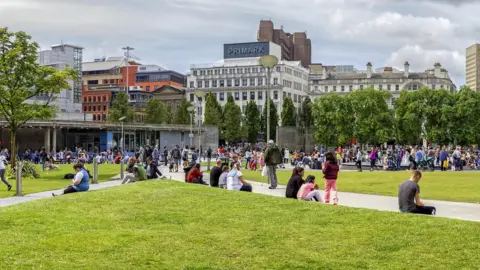UK's most polluted towns and cities revealed
 Getty Images
Getty ImagesUpdate 4 May 2018: This story, first published on 2 May, has been revised after the WHO issued corrected figures, including those that had originally put Port Talbot at the top of its list.
More than 40 towns and cities in the UK are at or have exceeded air pollution limits set by the World Health Organization, its new report has found.
The WHO estimates that 30 areas have fine-particle air pollution levels above 10 micrograms per cubic metre, with another 17 at that limit.
Areas that exceeded the level included London, Manchester and Swansea.
Dirty air can cause debilitating diseases and hasten death.
The figures on air pollution are contained in the WHO's report, which estimates that globally nine out of 10 people breathe air containing high levels of pollutants.
Most of the UK figures were collected between 2013 and 2015 and in some places estimates of fine-particle air pollution were made based on measurements of larger particles of pollution.
In the UK, Scunthorpe had the highest estimated level of fine-particle air pollution at 15 micrograms per cubic metre, though this was from 2013.
Fine-particle air pollution is particularly bad for us, penetrating deep into the lungs and cardiovascular system, causing diseases including stroke, heart disease, lung cancer and respiratory infections, the WHO says.
It estimates that, globally, seven million people die each year from exposure to such pollution, with most of these deaths being in low and middle-income countries, mainly in Asia and Africa.
The world's most polluted city in 2015, according to the WHO, was Muzaffarpur in India, with a figure of 197 micrograms per cubic metre - although that figure is under revision.
Pasakha in Bhutan, Delhi in India and greater Cairo, Egypt, also had very high levels.
However, while many UK towns had air pollution recorded at or above the WHO's recommended limit, in a number of places the levels are falling.
In London, for example, levels fell from 17 to 11 micrograms from 2013 to 2015, while in the same period there was a fall from 17 micrograms to 12 in Sheffield.
Simon Gillespie, chief executive of the British Heart Foundation, said the UK still had "a long way to go in the fight against air pollution".
"The UK government needs to show leadership by adopting WHO air quality guidelines into national legislation and in doing so, help to protect the nation's heart and circulatory health."
A spokesman for the government's Department for Environment, Food and Rural Affairs, said: "While air quality in the UK has improved significantly since 2010, this report from the WHO clearly shows the impact air pollution is having on the health of men, women and children in the UK and across the world.
"Tackling this important issue is a priority for this government which is why we have a £3.5bn plan to improve air quality and reduce harmful emissions and will set out further actions through a comprehensive Clean Air Strategy later this year."
The 30 UK places (and Gibraltar) that exceeded the limit of 10 micrograms per cubic metre:
Scunthorpe: 15 (estimate)
Gibraltar: 14
Manchester: 13
Swansea: 13
Gillingham: 13 (estimate)
Carlisle: 12 (estimate)
Chepstow: 12 (estimate)
Leeds: 12
Leicester: 12
Liverpool: 12
Grays: 12 (estimate)
Eccles: 12 (estimate)
Nottingham: 12 (estimate)
Plymouth: 12 (estimate)
York: 12
Prestonpans: 12
Royal Leamington Spa: 12
Sandy: 12
Sheffield: 12 (estimate)
Stoke-On-Trent: 12
London:11
Coventry: 11
Hull: 11 (estimate)
Londonderry: 11 (estimate)
Middlesbrough: 11
Norwich: 11 (estimate)
Southend-On-Sea: 11
Stockton-On-Tees: 11
Storrington: 11
Wigan: 11
The 17 areas that are at the limit:
Armagh:10 (estimate)
Birmingham: 10
Brighton: 10
Bristol: 10
Cardiff: 10
Eastbourne: 10
Harlington: 10
Newcastle: 10 (estimate)
Newport: 10
Oxford: 10
Portsmouth: 10
Preston: 10
Salford: 10 (estimate)
Saltash: 10
Southampton: 10
Stanford-Le-Hope: 10
Port Talbot: 10
